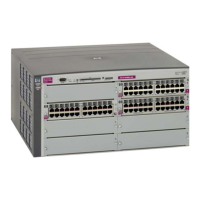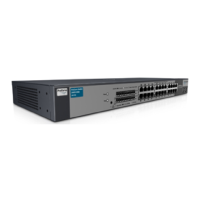OSPF 110
OSPF implementation in GbE2c software
The GbE2c Ethernet Blade Switch supports a single instance of OSPF and up to 4 K routes on the network. The follow-
ing sections describe OSPF implementation in GbE2c software:
• Configurable Parameters
• Defining Areas
• Interface Cost
• Electing the Designated Router and Backup
• Summarizing Routes
• Default Routes
• Virtual Links
• Router ID
• Authentication
Configurable parameters
In GbE2c software, OSPF parameters can be configured through the Command Line Interface (CLI), Browser-Based
Interface (BBI) for GbE2c Ethernet Blade Switches, or through SNMP. For more information, see “Accessing the
Switch.”
The CLI supports the following parameters: interface output cost, interface priority, dead and hello intervals,
retransmission interval, and interface transit delay.
OSPF traps—Traps produce messages upon certain events or error conditions, such as missing a hello, failing a
neighbor, or recalculating the SPF.
In addition to the above parameters, you can also specify the following:
Link-State Database size—The size of the external LSA database can be specified to help manage the memory
resources on the switch.
• Shortest Path First (SPF) interval—Time interval between successive calculations of the shortest path tree using the
Dijkstra’s algorithm.
• Stub area metric—A stub area can be configured to send a numeric metric value such that all routes received
via that stub area carry the configured metric to potentially influence routing decisions.
• Default routes—Default routes with weight metrics can be manually injected into transit areas. This helps
establish a preferred route when multiple routing devices exist between two areas. It also helps route traffic to
external networks.
Defining areas
If you are configuring multiple areas in your OSPF domain, one of the areas must be designated as area 0, known as
the backbone. The backbone is the central OSPF area and is usually physically connected to all other areas. The
areas inject routing information into the backbone which, in turn, disseminates the information into other areas.
Since the backbone connects the areas in your network, it must be a contiguous area. If the backbone is partitioned
(possibly as a result of joining separate OSPF networks), parts of the AS will be unreachable, and you will need to
configure virtual links to reconnect the partitioned areas (see “Virtual Links”).
Up to three OSPF areas can be connected to the GbE2c Ethernet Blade Switch. To configure an area, the OSPF
number must be defined and then attached to a network interface on the switch. The full process is explained in the
following sections.
An OSPF area is defined by assigning two pieces of information—an area index and an area ID. The command to
define an OSPF area is as follows:
>> # /cfg/l3/ospf/aindex <area index>/areaid <n.n.n.n>
NOTE: The aindex option above is an arbitrary index used only on the switch and does not represent the
actual OSPF area number. The actual OSPF area number is defined in the areaid portion of the command as
explained in the following sections.

